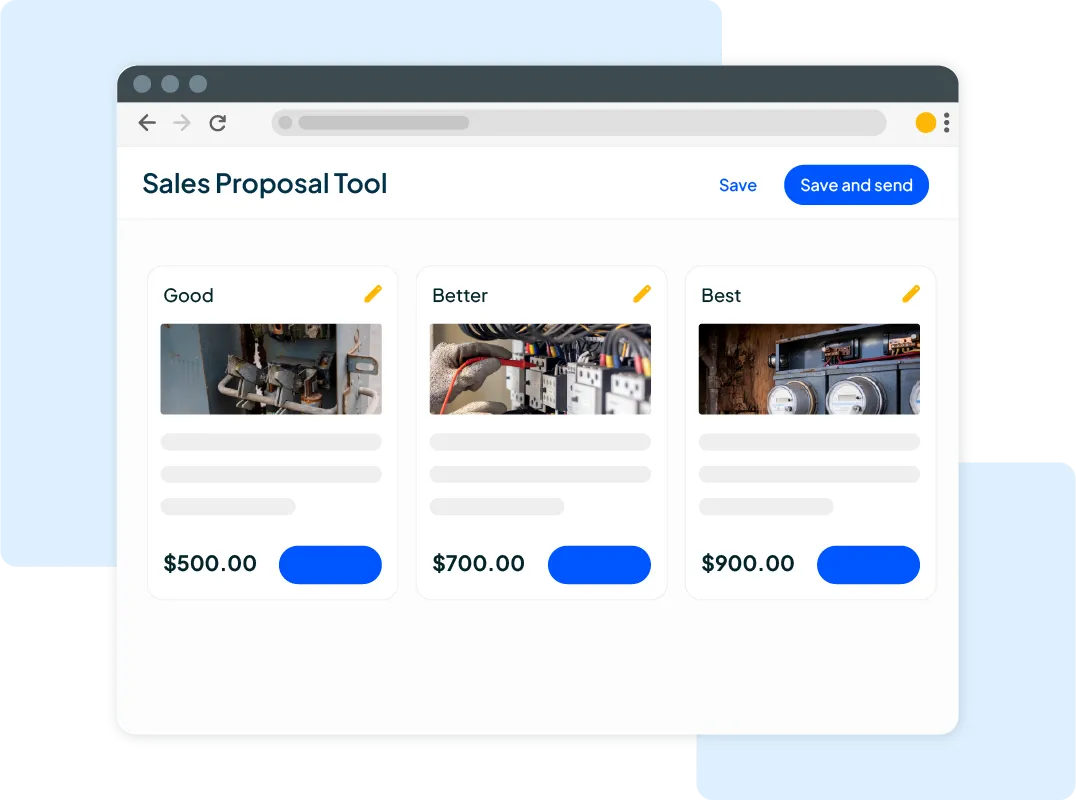Electrical Labor Cost Calculator
Download a copy of our free electrical labor cost calculator and use it on the go!
Get In Touch: 858-251-9751
Download our free electrical labor cost calculator today
Electrical Resources
More free tools for your Electrical business
Check out our complete library of free templates and resources for your electrical business.
This Electrical Labor Cost Calculator allows you to accurately estimate the cost of labor for a given electrical project.
What is an electrical labor cost calculator?
An electrical labor cost calculator is a tool used to estimate the cost of labor for electrical jobs. It takes into account factors like hourly wage, overhead costs, profit margin, and markup to determine a comprehensive labor cost.
Why should I use an electrical labor rate calculator?
Using a labor cost calculator helps ensure accurate and fair pricing for both your business and your customers. It provides a transparent estimate, helps in budgeting, and can prevent those pesky little disputes over labor costs.
How do you calculate an electrical labor cost?
To use this calculator and determine electrical labor costs, follow the seven steps outlined below.
A simple formula for calculating electrical labor rates might look like this:
Labor Cost = (Hourly Wage + Overhead Costs + Profit Margin) × Markup Factor
Hourly Wage: This is the hourly rate you pay each electrician for electrical jobs. It will vary depending on the electrician’s experience and skill level.
Overhead Costs: These are the indirect costs associated with running an electrical business. Think insurance, tools, equipment, office space, administrative costs, vehicle maintenance, and more. Divide your annual overhead costs by the total number of billable hours worked by your electricians in a year to get the overhead cost per hour.
Profit Margin: This is the percentage of profit you want to make on top of covering your average costs.
Markup Factor: This is a multiplier that helps cover the overhead costs, profit margin, and other miscellaneous expenses.
7 Steps to Pricing Electrical Labor
Electrical labor costs can depend on several factors. As you calculate, you’ll need to consider the skill levels of your team (master electricians, journeyman, or apprentice), geographical location, type of electrical work, overhead costs, and market demand.
It may seem complicated, but it’s not so bad! Let’s walk through it step by step.
Step 1: Calculate overhead costs
Average annual overhead costs include all fixed and variable assets required to operate the business. This includes rent, insurance, utilities, vehicle maintenance, office supplies, and more. These costs do not include payroll.
Step 2: Calculate the number of electricians on payroll
Figure out how many revenue-generating electricians you plan to employ over the next 12 months. Include any new hires or team reductions. For example, if you plan to expand into commercial projects, add those new employees into your calculations.
Step 3: Determine annual working hours per electrician
To calculate your team’s annual working hours, you need the total available working hours and the total non-billable hours (like vacation and holidays) in a year.
Example: Each electrician works 40 hours a week and gets 10 vacation days plus 7 holidays annually.
Available working hours: 40 × 52 weeks = 2,080 hours
Non-billable hours: (10 vacation days + 7 holidays) × 8 = 136 hours
Annual working hours: 2,080 – 136 = 1,944 hours per electrician
Enter this number (1,944) into the labor cost calculator.
Step 4: Calculate projected billable hours per electrician
Next, figure out the percentage of each electrician’s workday that is billable. Typically, 30% is average efficiency, while 50% is highly efficient.
Convert the efficiency rate into a decimal (e.g., 30% = 0.30) and multiply by the annual working hours:
1,944 × 0.30 = 583.2 billable hours per year per electrician
Formula:
Available Working Hours × Efficiency Rate = Projected Billable Hours per Electrician
Step 5: Calculate the hourly rate to cover overhead only
To determine this, first find the total billable hours for the whole team:
583.2 hours × 5 electricians = 2,916 total billable hours
Now divide annual overhead costs by total billable hours:
$100,000 ÷ 2,916 = $34.29 per hour
Formula:
Overhead Costs ÷ Total Billable Hours = Hourly Rate to Cover Overhead
Step 6: Calculate your break-even labor rate per billable hour
First, calculate payroll cost:
2,916 total billable hours × $28 per hour = $81,648 payroll cost
Add overhead costs to get total expenses:
$81,648 + $100,000 = $181,648 total expenses
Divide by total billable hours:
$181,648 ÷ 2,916 = $62.29 per billable hour
Step 7: Calculate your profitable labor rate
To reach a 30% profit margin, first convert to decimal:
30% ÷ 100 = 0.30
1 – 0.30 = 0.70
Now divide break-even rate by this amount:
$62.29 ÷ 0.70 = $88.99 per billable hour
Formula:
Break-Even Rate ÷ (1 – Desired Profit %) = Profitable Billable Rate
